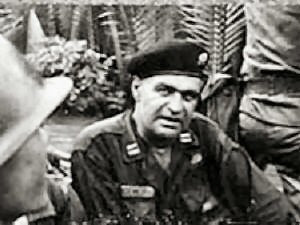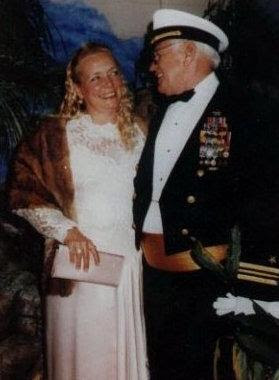On Tuesday, December 30th, 2008, retired Lieutenant-Commander Roy H. Boehm died at his retirement home in Punta Gorda, Florida. He was 84 years old.
Boehm enlisted in the US Navy at the age of 17, a few months prior to the Japanese attack on Pearl Harbor in 1941. Having already received training as a diver, he was one of those tasked to recover the bodies of casualties from the hulk of the USS Arizona. He described the experience in his autobiography, ‘First Seal‘, as follows:
I found myself peering down into the murky harbor water to the shadowy outline of where the battlewagon Arizona lay some 30 feet or so beneath the bay’s surface. The oily, restless water lent the tomb a ghostly, otherworldly air. All corpses easy to reach had already been removed and sent stateside for burial. At barely 18 years old, I was about to be introduced to the human detritus of war.
I had never seen a dead person outside a casket, but macho was the order of the day. I figured that I could outmacho any hairy-legged swinging dick aboard the Duncan. I had already won a pending court-martial because of a raucous night of liberty in Panama on the cruise through to the Pacific. Women and booze marked the true man-of-warsman.
The ship’s commander, Lt. Comdr. Edmond B. “Whitey” Taylor, who became and remained my mentor and “sea daddy” for most of my career in the Navy, had shaken his head. “Boehm, you seem to be a damned good sailor as long as we keep you at sea,” he said.
“It’s women and booze, sir,” I apologized. “I can’t resist ’em, sir.”
“Boehm, you’re going to have to learn to keep quiet sometimes.”
“It’s a failing of mine, sir. I have a bulldog mouth.”
“Don’t let it override your Pekinese ass,” he scolded mildly.
Arizona lay majestically intact on the sand. She lay at an angle on her port side with a gaping hole down through the center of her decks. Clouds of feeding fish swarmed the ship, fading out of our path in gentle waves, like wind through a ripe wheat field. Debris of all sorts scabbed the ship – drifting lines, snags of canvas, netting, and tackle. It sloughed off the vessel like I imagined skin sloughed off waterlogged corpses.
Sucking air, my dive mate and I slipped into the ship’s dark bowels through her terrible wound. Underwater torches illuminated watertight hatches, most of which hung ajar, and gangways where more wreckage floated eerily in the yellow-white liquid light. Shadows seemed to breathe and undulate.
I loosened a closed hatch by undogging the locks, braced my sneakered beet against the bulkhead, and pulled. I thrust my torch out ahead and cautiously led the way through into the compartment beyond. Our entry stirred the water and disturbed the haunted rest of several corpses. They moved about in a kind of weird slow-motion dance. Hair, skin, and minute particles of flesh misted into the water, attracting a feeding frenzy of tiny fish.
I flashed my light back and forth between the cadavers, as though covering myself against a surprise attack. A large crack in the bulkhead had admitted the sea’s tiny scavengers. Light beams picked out black cavities where fish had sucked out eyeballs, gleamed on teeth exposed by lips having been gnawed away. Dead arms slowly beckoned, as though attempting to draw us with them into their watery graves. Silent anguished screams filled the compartment deafening me.
I back-swam. Striking my head on the edge of the steel hatch stunned me momentarily. I shot out of the macabre tomb like a squid, my partner directly behind me, which my stomach deposited it’s contents into my mask. I no longer felt so damned macho, what with my poor young heart pounding like bombs exploding and the vomit in my mask choking and blinding me and burning my eyes and nose with stomach acid. I thought I was drowning in my own breakfast.
I shot for the surface, gagging and retching and panting to reach air. “That’s a graveyard down there!” I gasped upon surfacing.
I hated the Japanese personally as I probed below the Arizona’s decks. I never expected diving to be like this. I never expected the sea to contain such horrors. I never thought I would feel relieved to get out of the water.
Boehm left Pearl Harbor aboard the USS Duncan, a Gleaves-class destroyer. The photograph below shows her five days before the Battle of Cape Esperance in October 1942.
USS Duncan was sunk during that battle. Boehm abandoned ship after helping with rescue efforts, and suffered the extreme trauma of having a shipmate and friend ripped from his arms by a shark while waiting for rescue. He described the experience as follows:
A dark shape deep, deep below. Rapidly growing larger. Larger. Like looking through a zoom lens and zooming suddenly to maximum close-up. Screams welled into my throat, blocking it.
Big and powerful, the fish brushed sandpaper-rough against my bare legs.
I screamed then, all control lost.
Dubiel screamed too. He must have had some awareness at the last instant as his body exploded out of the water. He twisted violently in the white froth and then he was gone in the attack, wrenched from my grip, scream broken off to linger forever in my nightmares.
It was all over that fast. A smear of red stained the sea, trailing down into the depths. I lost all control. I beat the water frantically with arms and legs as I swam with renewed desperation, knowing deep down I could never outswim sharks but determined to make them work for their supper.
Boehm was rescued later that day, and went on to serve through the rest of the war. He briefly left the service, but rejoined, and served in the Korean War. In 1955 he qualified as a member of the Underwater Demolition Teams (UDT) at the age of 31.
Commissioned as an officer, Boehm formed the first SEAL team on the East Coast of the USA shortly before the Cuban missile crisis. Its designated Commanding Officer didn’t arrive until some months later, making him the Team’s de facto commander for a time – hence his nickname among many as ‘First Seal’. His unorthodox methods of getting the equipment and weapons the Team needed attracted extremely angry official attention, and five separate inquiries. Eventually, all were quashed by a Presidential authorization that enabled him to get whatever he needed in the fastest possible way. His team was ready to go into Cuba when the crisis erupted, but that proved to be unnecessary.
Boehm was later sent to Vietnam, where he served as an advisor. He is shown below during his assignment there, in the rank of Lieutenant.
He retired from the US Navy in 1971 as a Lieutenant-Commander, after 30 years of service. In retirement he learned to fly, and was an enthusiastic participant in motorized parachute competitions. He is shown below with his wife, Susan.
He remained active in the US Special Forces community, working to support the UDT/Seal Museum at Fort Pierce, Florida.
He suffered from ill-health in later years, probably the result of the immense stresses to which he subjected himself in war and in peace. In an e-mail to a friend a few years ago, he reflected on his approaching death:
I guess we are all going slowly through the completion of our tour of duty, ie: death. I look at death as a new adventure with a don’t sweat it attitude. Any foot prints you may have accidentally made, will be washed away with the next wave.
Life is loaned to you, live it, love it, for the joy of what you love, and whom you love. Leave your ego, status, and possessions hanging on the worlds quarter deck because you are going out with what you came here with; hopefully it will be a positive memory to a few.
In the mean time if you don’t use what you got you will lose what you got.
Perhaps the best tribute to LCdr. Boehm was paid some years ago by author John Weisman, who singled him out as an example of true leadership. The whole article is highly recommended reading, but here’s a brief excerpt:
Roy Boehm’s battles with the Navy establishment didn’t make him very popular on Admiral’s Row. But when he asked for volunteers to jump with him into Cuba during the period we call the Missile Crisis, every one of his men stepped forward. He’d put his life and his career on the line for them — and they were willing to do the same for him. It was, he says now, his proudest moment as an officer.
Boehm has always said that leadership can be defined in two words. Those words are “Follow me.”
LCdr. Boehm didn’t want any fuss made about his death. As his widow said yesterday:
His widow, Susan Boehm, declined to be interviewed about her husband. In fact, she pleaded that no story be written.
Susan said she was trying to carry out her husband’s last wish, that his death not be publicized.
He wanted no obituary, no funeral service and no fanfare over his death, Susan said.
“He just wanted to go in peace,” she said.
I sympathize, Mrs. Boehm: but when a great man passes – and to generations of SEALS and other Special Forces operators, LCdr. Boehm was precisely that – his passing flames across the sky like a meteor, drawing a salute and a “Godspeed, brother!” from those who knew him. I was not among that privileged number, but I knew him by reputation. These few words are my acknowledgment of the debt we all owe to him, and men like him, for their work to keep us free. As George Orwell put it:
People sleep peaceably in their beds at night only because rough men stand ready to do violence on their behalf.
Roy Boehm was such a man. We live safely today because of him, and those like him.
Rest in peace, Sir, and may God grant you eternal rest.
Peter




I thank God for men like Roy Boehm.
Forgive me for paraphrasing the quote, “Do not grieve that a man like this a died. Rejoice that a man such as this lived.”
Well written Sir!
To LCDR Boehm:
Sailor rest you oar
Fair winds and following seas Shipmate… You toil is done.
Roy Boehm taught me the basics of being a Brown Water Sailor in early 1967 at Mare Island. He was an inspirational leader and a superb teacher with a lifetime of combat experience to back up his instruction.
I'm saddened to hear of his passing.
He has gone to a better place from a plce he made better.
RIP, Shipmate